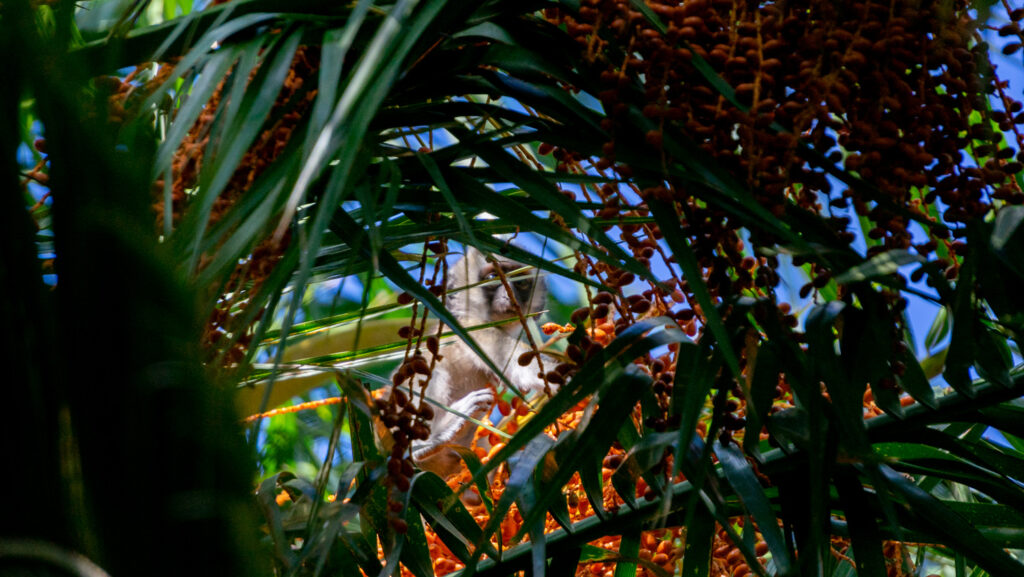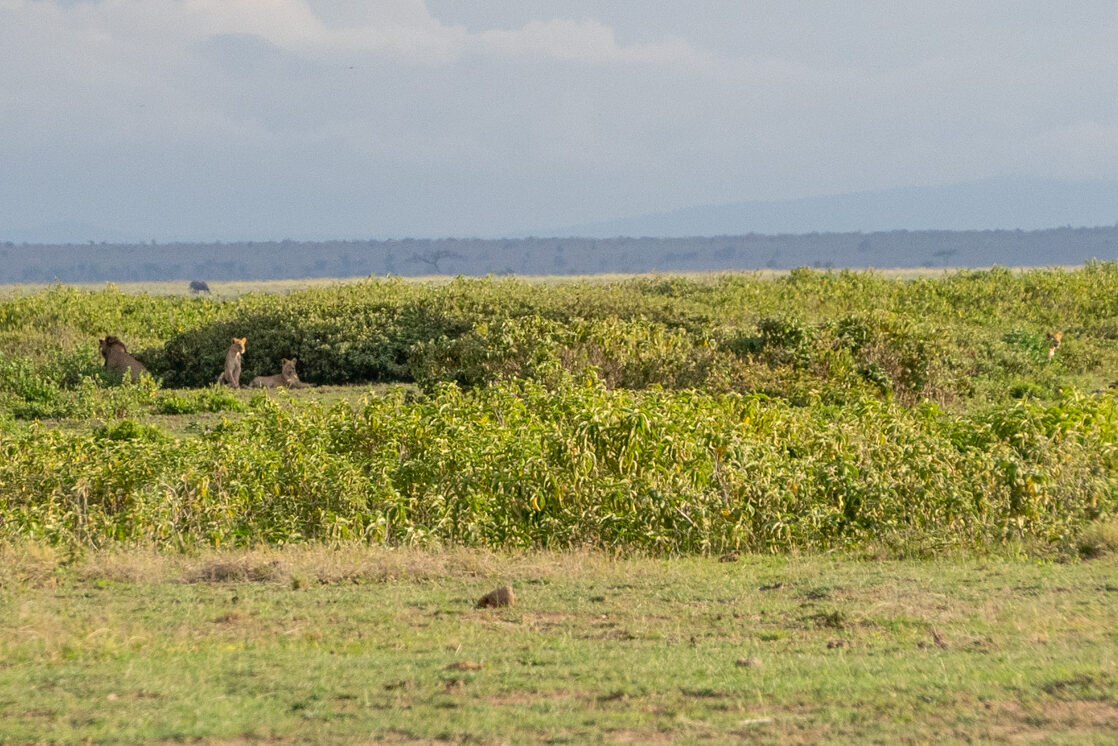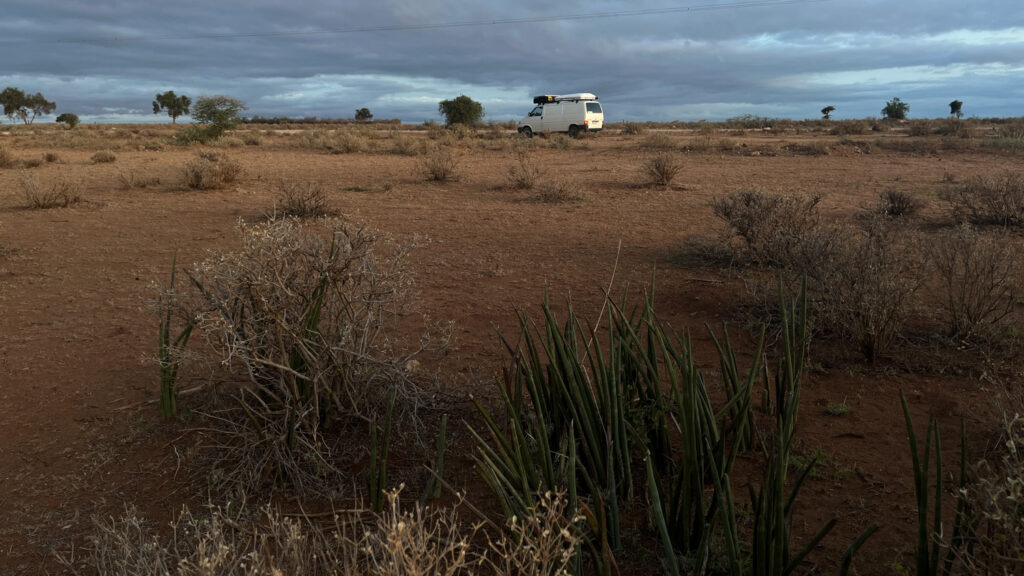« From 30th of April to 3rd of May »
First a stop to the garage
Back on the paved roads, our next step is to drive south to visit Amboseli. This national park is located at the foot of Kilimanjaro. The animals evolve in an exceptional setting. However, Uyo is not at his best… when we accelerate, it makes some rattling noises at the right front. Not very reassured, we visit a garage to identify the problem. In the pit, we observe the mechanics of Uyo. Silent blocks (bushes made of rubber and metal part that reduces vibrations) are breaking down at the suspension rack. Still linked to the steering wheel, the steering ball joints are too soft.
We will find these parts on our way to Nairobi. In the meantime, no more offr-oad. We hope to be able to solve the problem quickly to have time to take Nicolas to Amboseli. We arrive in the capital late Wednesday. David, the garage manager, is not there. We learn that the next 2 days are public holidays and that most of the spare parts stores are closed.


We take our pain in patience and find a comfortable campsite with swimming pool to wait for Saturday, the opening of the garage. spars for our VW are not easy to find even though we are in the capital. David does his best to replace the used parts so that we can get back on the road quickly. For Nicolas, the days are counted. He leaves on Tuesday and 3 days are necessary for the small expedition to Amboseli.



Amboseli, a road full of pitfalls
We finally take the road again on a late Saturday, the noise is still there but much lower. We have an appointment with David on our return, after having dropped Nicolas at the airport. We swallow the kilometers of asphalt in direction of the south until the sunset. We bivouac in the wilderness less than 2h30 from the park entrance. Kilimanjaro is usually clear of cloud early in the morning. We don’t want to miss the opportunity to see it, with its snowy summit, in the background of the savannah animals.



We leave the camp at dawn, the red colors of the sun offer a nice show. Without intermission, we continue to be amazed by the Kilimanjaro always more imposing as we approach. For the last kilometers, the tarred road gives way to the track. It is a secondary track that we have to take because the main one is under construction. The vibrations provided by the corrugations of the road are constant. A real African massage as they say here.


We are only 8 kilometers away when we hear an explosion noise, coupled with a white smoke, at the right front of the vehicle. The strong smell that escapes does not help to reassure us. Shocked, we stop immediately. Shit! What happened? Another flat tire? No, everything is fine on this side. Is it serious? We don’t believe it, we just get out of the garage. So close to the goal, we are again blocked and the safari seems really compromised…
Smoke in the front is not a good sign. We hope that the engine is ok! We discover that it’s the front right shock absorber that exploded. It overheated with the repeated shocks. However the road was quite simple if we compare it with the expedition to Lake Turkana (see Article 16 Turkana, the biggest alkaline lake in the world and its tribes)
We remember then, that in the garage, we also reinflated the tires. Too rigid, they did not help much to absorb the shocks. In short, we have to find a solution. We consider different options. Drive quietly to the asphalt road and look for a garage? But it’s Sunday, we will have to wait until Monday and go back to Nairobi to drop Nicolas off… Repairing on the spot? After all, we have our old shocks in the van and good tools.


Let’s go! Besides, we have a good internet connection to find the instructions. It is almost too easy, it remains only a nut to unscrew. Thin! We do not have a key of 18. We try otherwise without success. To explain quickly, we get out of it with the help of a mechanic of the national park who joins us with the famous key. In two times three movements, the shock absorber is replaced. We are a little disappointed not to have finished the replacement alone but we know now that with the good tools (that we are going to buy of this step) we would have been able to come to end of it.
Incredible landscapes at the foot of Kilimanjaro
Let’s go ! It was not easy to get to this park but we did not give up and here we are! The day is well underway, so we choose to use our 24 hours entry permit on two half days. The safaris are often very tiring, the idea of taking a break to better leave the next day pleases us well.


The park is very marshy, it has many lakes. In this season, it is very green. The first animal that we observe is a wildebeest, or rather a family of wildebeest, the park is full of them. Then the encounters follow one another: buffalos, zebras, elephants, gazelles, hippos etc…






The hippos are massive, they are surely the biggest we have seen so far. The profusion of birds is a spectacle for the eyes, all the colors of the palette are gathered. Without forgetting the black-headed velvet monkeys and the baboons. Nicolas, a great fan of monkeys, could spend the whole day observing them.






We wander in the park until 6pm, the closing time. After the gate, we look for a camp to spend the night. The road is very deserted, a lot of sand or dried earth and some acacias. There are too few trees to be completely hidden from the road, but let’s go off the path to avoid being disturbed. Settled in, we start with a quick shower. With all this dust, the fresh water feels good! With this nice view on Kilimanjaro and the sunset, we are better than at the hotel!
Nicolas leaves to take some pictures at nightfall, with a flashlight, while we prepare the meal. While the last lights of the sun have just gone out, he comes back very quickly to us. Not very reassured, he says he saw two shining eyes at ground level not far from him. At only two kilometers of the national park which does not have barriers, the felines or hyenas can prowl the night. Neither one, nor two, we take our stuff to return inside. The heart still beating, we keep the door open to finish the cooking of our pasta. Nicolas always observes the eyes which approach gradually. They are at first 50m away, then 30, 25, 20… they seem now very low to be an animal as big as a feline. It could be a jackal or a mongoose… 15m, 10m… then, at the limit of the lighting of our spot, the eyes disappear. The animal is probably afraid and turns back. That falls well, the meal is ready. We settle down all inside, still under the shock and full of adrenalin.
The next morning, we set up camp at 6:30 am for our second half-day safari. From now on, we know the park a little better. The Kilimanjaro is revealed little by little making our photos unique.



The winds have changed, today luck is on our side. Nicolas sees his first lions, two females are napping in the grass while an elephant approaches. A little later, it is the whole family that we discover in the distance with cubs. Only binoculars allow us to see them in action.


To finish in beauty this morning, we meet a family of hyenas. Once again, Nicolas is delighted. One of his favorite animals. We see in the distance the 5 cubs who play between them. We are at the end of the rainy season and the babies are there.



A last encounter before Nicolas’ departure
Maasai live in some areas of the park. When we cross them, they ask for water. At the exit of the park, it is very close to one of their temporary village that we will spend the night. In Kenya, they speak very well English. It is the opportunity for us to learn more about them:
- The men travel in groups for a few weeks to feed the animals. At night, they create a temporary village with acacia branches to protect the animals from predators.
- In a Maasai family, some children have the chance to go to school. The parents choose according to the physical and intellectual conditions of their children.
- Decades ago, men would hunt lions to protect the village and the herds and to be crowned with glory. Now, they understand the tourist interest and do not go hunting anymore. Nevertheless, when the Maasai disagree with the government that wants to expand the park’s boundaries, they kill lions in retaliation.
- Every one year old baby is scarified with a red iron on the cheek. In the past, this mark was meant to protect against AIDS. Now it is used as a Maasai recognition mark.
- The Maasai are polygamous. A man can buy several wives if he can afford it. The woman then joins the village and creates her own house out of cob (mud, branches and manure).


The adventures end here for Nicolas. He flies back to Paris on Tuesday, late in the evening, with a full belly after the Ethiopian restaurant of the last evening. As for us, we have to go back to the garage to finish the repairs before leaving towards West and Uganda.




thank you very much for the information
Pingback: #23 From Lake Tanganyika to Lake Kariba, Zambia